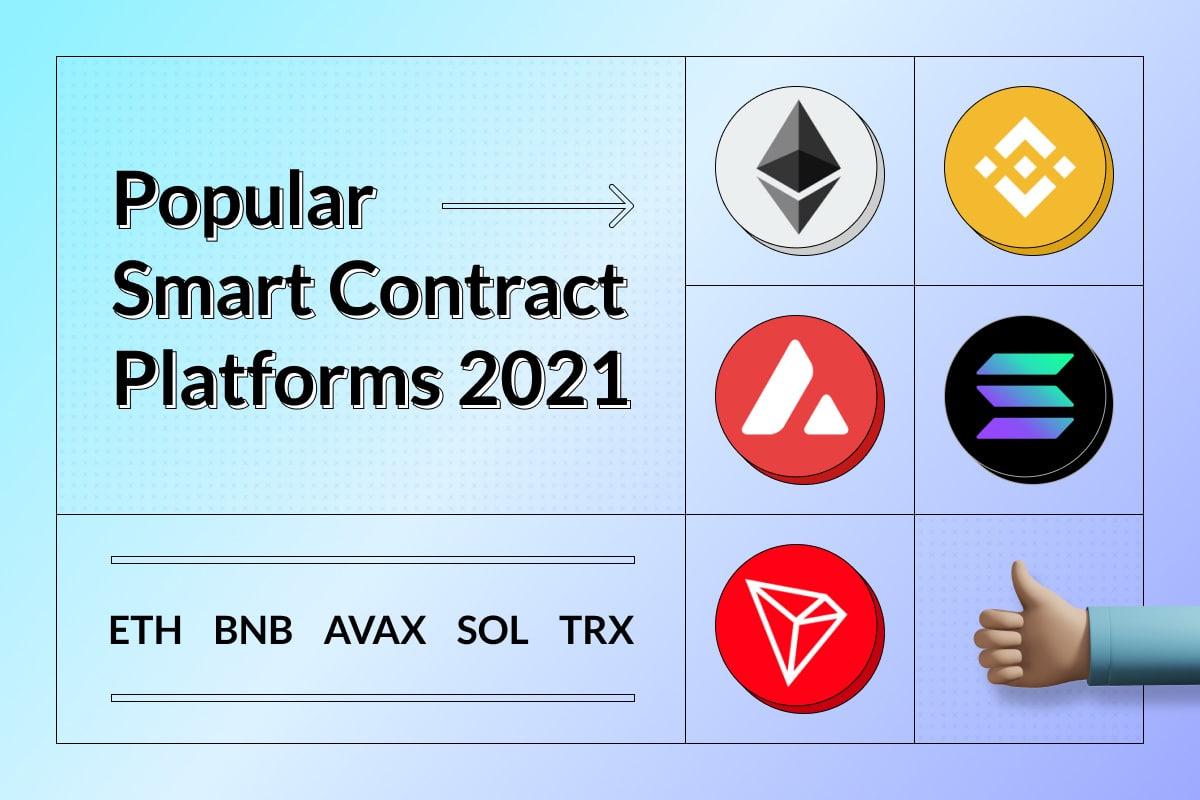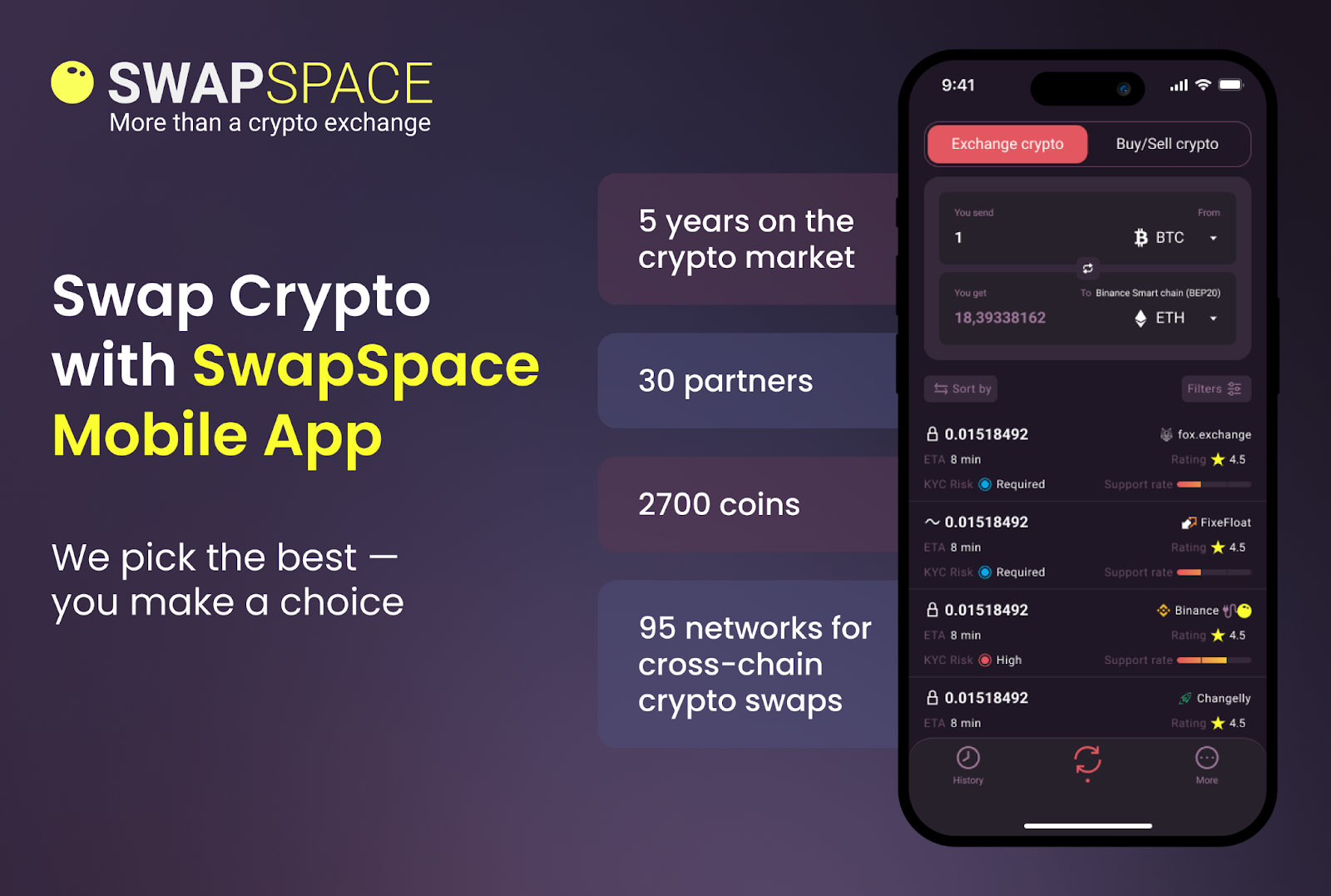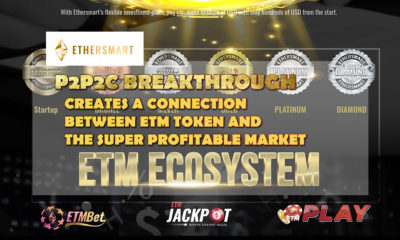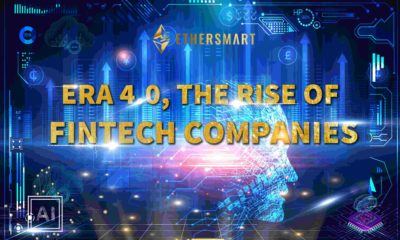Blockchain
A hands-on experience on some of the most popular smart contract platforms

In 2021, many smart contract platforms competed for users’ attention and attempted to be the next Ethereum killer. The terms DeFi, GameFi, and NFT, have been all over the media lately, and any of these would not be possible without smart contracts. As more smart contract platforms are introduced, it becomes hard for newcomers to choose which is right for them. This article will examine some of the most popular smart contract platforms and share our hands-on experience with them.
Ethereum
Token: ETH
TPS: 10
Ethereum is the world’s first smart contract platform. Developers create decentralized applications (dApps) on the Ethereum Virtual Machine (EVM) with an object-oriented programming language called solidity. Users can interact with dApps that operate autonomously. Since Ethereum is the first smart-contract-enabled blockchain platform, it has a lot of active developers and has the most Total Value Locked (TVL) in DeFi as far as blockchains are concerned. However, despite being the most popular smart contract platform, it still has a few downsides that make us try to stay away from it when possible. One drawback is the slow transaction speed since Ethereum can only process around 10 transactions per second (TPS). The other problem is the hefty transaction fee it charges when the network is busy, in which the fee may sometimes cost more than the transaction per se.
Binance Smart Chain
Token: BNB
TPS: 60
Binance Smart Chain (BSC) is a smart contract blockchain that is fully compatible with the EVM, so developers can leverage existing tools to write dApps without having to learn an entirely new language. In addition, the increase in transaction speed compared to Ethereum is welcoming. BSC started to gain traction earlier last year, it forked a lot of Ethereum projects that bootstrapped the entire ecosystem, and in the latter part of last year, we see GameFi booms on BSC. One most notable concern that many community members have is the centralization of the Binance chain since Binance is a centralized exchange, and most of its validators are connected to Binance. Nonetheless, BSC has a unique and strategic position in the entire crypto ecosystem.
Avalanche
Token: AVAX
TPS: 4,500
Avalanche is an open-source platform for launching DeFi applications and enterprise blockchain deployments in one interoperable, highly scalable ecosystem. Avalanche is the first smart contract platform that confirms transactions in under one second with finality on every block. It provides a new consensus mechanism with an adaptable platform optimized for enterprise adoption and developer needs while solving the challenging problems of scaling and security. The AVAX rush incentive plan also ignited the whole Avalanche ecosystem last year, with large price swings in the latter half of the year. We miss the low transaction fees that Avalanche offered at the very start. Another concern we have is their failure to keep up to date with various promises such as burning the foundation’s staking rewards and the introduction of feeless transactions. If Avalanche could significantly reduce its fees and improve communication while keeping its promises, it’s still a smart contract platform worth keeping an eye on.
Solana
Token: SOL
TPS: 2,000
Solana is a high-performance open-source blockchain. It provides a platform for dApps and next-generation protocols. With its Proof of History (PoH) consensus mechanism, the Solana blockchain allows for breakneck transaction speeds, claiming to scale to over 50,000 TPS on an open network, which is said to be possible due to Solana’s novel approach.This deterministic checkpointing mechanism that is used in place of synchronous consensus. However, Solana’s actual TPS is around 2,000, with more than 3/4 of these transactions being vote transactions. The seemingly inflated TPS widely promoted to the public might reflect the questionable design of the Solana platform. Even though it was once regarded as a crypto rising star, with its six blockchain outages happening in the last month alone, Solana is facing fundamental questions about its network stability, as well as the ability to maintain itself as a Wall Street darling.
TRON
Token: TRX
TPS: 2,000
TRON is an innovative open-source blockchain that focuses on providing a cost-effective settlement solution with the ultimate goal of decentralizing the internet. The high level of scalability offered by the system and its mandate for low costs are attractive propositions for those considering taking their first step into the crypto world. Since last April, the amount of Tether USDT on TRON has surpassed Ethereum to become the No.1 worldwide. TRON became the preferred blockchain for many when transferring and converting stablecoins because of its low fees. The TRON network’s increasing dApps and NFT projects also attracted many new users from other blockchains. However, we noticed that newcomers sometimes brought up the concept of bandwidth and energy on the TRON network. Although understanding bandwidth and energy is not necessary to make a transaction, users should be encouraged to look into them as utilizing these resources by staking a certain amount of TRX would enable one to send transactions or interact with smart contracts for free.
Throughout last year, we saw many smart contract platforms rising to compete with Ethereum, and each of them has its pros and cons. There is an incredibly increasing demand for a good smart contract platform, and every platform will eventually have its place in the ecosystem. Investors, users, and developers should take a closer look at each of these blockchains and pick the one that matches their needs best.
Blockchain
Beyondi and Tokenis3 Collaborate to Transform Asset Tokenization

In a bold move to reshape the future of digital assets, Beyondi and Tokenis3 have joined forces to elevate real-world asset (RWA) tokenization to new heights. This strategic collaboration merges Tokenis3’s legal expertise in Regulatorily Enforceable Tokens (RET) with Beyondi’s innovative blockchain solutions, aiming to revolutionize security, compliance, and efficiency in the rapidly evolving digital asset space.
The Future of Digital Asset Innovation
RWA tokenization is not just changing how ownership is managed, it’s addressing some of the most pressing challenges in traditional asset ownership: illiquidity, high costs, and limited accessibility. Through their partnership, Beyondi and Tokenis3 are committed to accelerating these advancements.Central to this mission is Tokenis3’s Tokenization Assessment Report (TAR), a comprehensive evaluation framework that guarantees digital assets meet the most rigorous legal and technological standards. Beyondi strengthens this foundation with secure, scalable, and adaptable blockchain infrastructure designed to empower global businesses and institutions to thrive in the digital age.
Beyondi: Leading Blockchain Innovation Since 2015
Since its inception in 2015, Beyondi has been a spearhead in blockchain and emerging technologies. The company empowers founders, teams, and investors to navigate the complexities of the crypto market with confidence. Offering a wide suite of services, ranging from R&D venture building and advisory to incubation and fundraising, Beyondi seamlessly blends technical excellence with market insight to deliver transformative solutions across industries such as finance, healthcare, government, and entertainment.
Collaboration is at the heart of Beyondi’s approach. Using methodologies like Rapid Application Development (RAD) and Kanban, the team works closely with clients to deliver agile, innovative solutions. With expertise spanning IoT, Hyperledger frameworks, web and mobile development, and team augmentation, Beyondi is uniquely positioned to craft tailored, future-ready blockchain solutions.
Tokenis3: Redefining Secure and Compliant Tokenization
Tokenis3 emerges as a pioneer in digital asset assessment and tokenization, providing the essential trust and security that is lacking in today’s complex digital landscape. Their TAR establishes enforceable legal terms, ensures technological compliance, and prioritizes sustainability, a forward-thinking approach that sets them apart, offering a robust framework for both issuers and token holders. This approach enhances the credibility and security of tokenized assets, fostering trust and long-term engagement.
Shaping the Future of Asset Tokenization
The collaboration between Beyondi and Tokenis3 signals a new era for asset tokenization. By combining their respective strengths, the two companies aim to establish groundbreaking standards for security, transparency, and efficiency in the digital asset ecosystem. This partnership is not just about improving the present, it’s about responsibly shaping how assets are created, managed, and secured as the world moves forward in the digital age.
Blockchain
Upcoming Layer 1 merging from UAE: Gaya Blockchain

Gaya Blockchain is an upcoming innovative blockchain that unifies gaming, decentralized finance (DeFi), SocialFi, and real-world asset tokenization into a single, user-friendly ecosystem.
Raised 20 million AED from Capstone Technology Group as their lead VC based out of UAE.
Gaya will be powered by its native utility token, GayaCoin, GAYA aims to bridge fragmented digital domains while promoting sustainability, inclusivity, and user empowerment.
– GayaCoin public-sale is mentioned to be released Q1 2025.
GAYA has ambitions to not just please the institutional market as the most advanced Blockchain coming from UAE but also to facilitate a better consumer engagement than EVM for developers and users.
Founding team Abdullah Al-Maksour, Aws Bashir & Sanad Al-Asiri.
Twitter (X): https://x.com/GayaBlockchain
Instagram: https://www.instagram.com/gaya.blockchain?igsh=MTFwY3E2eGxuZzd2dA==
Website: https://www.gayablockchain.io/
Key Highlights
- Unified Ecosystem: GAYA integrates diverse digital domains like gaming, DeFi, SocialFi, and tokenized real-world assets into a cohesive platform.
- Sustainability: The platform pioneers eco-conscious blockchain practices, including carbon tracking and incentivized green initiatives.
- Empowering Users: Democratizes access to premium assets and decentralized governance, giving users control over the platform’s future.
- Strategic Regional Leadership: As the first Layer 1 blockchain in the UAE, GAYA is uniquely positioned to bridge local and global blockchain adoption.
Vision and Mission
GAYA envisions a blockchain future driven by sustainability, inclusivity, and user empowerment. Its mission includes:
- Unifying Digital Ecosystems: Bringing together gaming, DeFi, SocialFi, and tokenized real-world assets on one accessible platform.
- Promoting Sustainability: Adopting eco-friendly blockchain practices, including low-energy protocols and incentives for green initiatives.
- Empowering Users: Ensuring decentralized governance and broad access to premium digital tools.
Ecosystem Overview
GAYA operates on a scalable Layer 1 blockchain and supports decentralized applications (dApps) powered by GayaCoin. Key components include:
1. Play-to-Earn Gaming
- Players earn GayaCoin and NFTs, which can be traded, staked, or reinvested within the ecosystem.
- Combines engaging gameplay with tangible financial rewards.
2. DeFi Platform
- Offers staking, lending, and borrowing services focused on sustainability.
- Prioritizes green investment opportunities.
3. SocialFi Integration
- Rewards content creators via decentralized revenue-sharing models.
- Features innovative governance structures to empower users.
4. Real-World Asset Tokenization
- Enables fractional ownership of tangible assets like renewable energy projects.
- Facilitates eco-conscious investments, making sustainable assets more accessible.
Strategic Positioning
As the UAE’s first Layer 1 blockchain, GAYA integrates culturally relevant and energy-efficient solutions to drive adoption both locally and globally. The platform’s unique positioning allows it to:
- Lead Sustainability: Through low-energy protocols and eco-incentives, GAYA minimizes its environmental impact.
- Empower Users: Fosters inclusivity with decentralized governance, enabling users to shape the platform.
- Support Developers: Provides robust tools like SDKs, APIs, and a Testnet, coupled with incentives such as grants and bug bounties.
Core Features of GAYA
GAYA’s unique infrastructure is designed to tackle major blockchain challenges like scalability, sustainability, interoperability, and governance. Below are its standout features:
1. Layer 1 Blockchain
- Proof-of-Stake (PoS) consensus mechanism eliminates energy-intensive mining.
- High Throughput: Processes thousands of transactions per second (TPS) with minimal latency.
- Security and Decentralization: Ensures robust network integrity without intermediary chains.
2. Eco-Conscious Design
- Carbon Tracking: Records the carbon impact of transactions, promoting eco-conscious usage.
- Sustainability Incentives: Rewards users who support green initiatives.
- Energy Efficiency: PoS minimizes energy consumption while maintaining security.
3. Interoperability via Gaya Virtual Machine (GVM)
- Ethereum Compatibility: Fully supports Ethereum Virtual Machine (EVM), enabling seamless migration of Ethereum-based dApps.
- Enhanced Collaboration: Promotes interoperability between GAYA and Ethereum ecosystems.
- Scalability: Built to handle large-scale dApps with consistent performance.
Key Milestones and Future Outlook
- Funding Success: GAYA has raised over 20 million AED from Capstone Technology Group, a leading UAE-based venture capital firm.
- Token Generation Event (TGE): Scheduled for Q1 2025, the launch of the $GAYA token marks a significant step forward.
- Leadership Team: The platform is led by Abdullah Al-Maksour, Aws Bashir, and Sanad Al-Asiri, all UAE residents with a vision to shape the blockchain landscape.
Why GAYA Stands Out
- Sustainability Focus: By embedding green practices and rewards, GAYA aligns with global sustainability goals.
- User-Centric Approach: Decentralized governance ensures users have a say in the platform’s evolution.
- Innovative Technology: GVM’s compatibility and high-performance features enable seamless dApp integration.
- Regional and Global Impact: As the UAE’s pioneering Layer 1 blockchain, GAYA bridges the gap between regional innovation and global adoption.
Conclusion
GAYA represents a paradigm shift in blockchain technology by seamlessly blending gaming, DeFi, SocialFi, and real-world asset tokenization. Its commitment to sustainability, inclusivity, and user empowerment makes it a standout platform in the blockchain space. With a robust infrastructure, eco-conscious design, and a forward-thinking team, GAYA is poised to redefine how digital ecosystems operate, both in the UAE and beyond.Stay tuned for the GayaCoin TGE launch in Q1 2025.
Blockchain
SwapSpace app review: seamless crypto exchanges anytime, anywhere

Cryptocurrency swaps have traditionally been riddled with challenges: complex processes, hidden fees, and the hassle of comparing rates across multiple platforms. SwapSpace revolutionized this landscape as a crypto exchange aggregator, offering a user-friendly solution to streamline swaps. Now, with the launch of its mobile app, SwapSpace takes convenience to a whole new level.
What is the SwapSpace Mobile App?
The SwapSpace mobile app brings the platform’s celebrated features to your fingertips. Acting as a one-stop solution for crypto swapping, the app allows users to compare rates from over 30 trusted exchange partners and access 2,700+ coins—all with zero extra fees.
You can connect your wallet when logging into the app and enjoy the benefits of the Invaders Loyalty program, collecting diamonds and using them to upgrade your invader for higher cashback levels.
How It Works
Swapping crypto on the SwapSpace app is as easy as 1-2-3:
- Select the cryptocurrencies you want to exchange.
- Compare offers from multiple providers and pick the best rate.
- Enter your wallet address, the one you’ll use to receive your crypto, and confirm the transaction. You will be given an address to send your crypto to and plenty of time to send the coins to it.
- You can now expect the incoming transaction with your crypto in your wallet. The app will keep you updated on the status of your swap via push notifications.
In just a few taps, your crypto is swapped and sent directly to your wallet.
Key Features
- Rate Comparison: The app aggregates real-time rates from top exchanges like Binance and Bybit to ensure you always get the best deal.
- Cross-Chain Swaps: Bridge assets across 95 blockchains effortlessly.
- Ease of Use: The intuitive interface makes it accessible to beginners while offering the flexibility advanced users need.
- NFT-based Loyalty Program: Earn up to 50% cashback on revenue share by upgrading your Invader NFT by spending Diamonds. Earn double Diamond rewards by performing swaps exclusively in-app.
- Extra Rewards: To commemorate the launch of the mobile application, every 100th swap done through the app will reward the user who did it with a prize of $100 in USDT.
Why Choose SwapSpace Mobile App?
The app is perfect for traders, investors, and crypto enthusiasts alike:
- For Traders: Save time and money by comparing rates instantly.
- For Beginners: A simple, no-sign-up platform to start your crypto journey. Discover new meme coins as soon as they appear on trading platforms.
- For Privacy Advocates: Registration-free swaps for maximum security.
- For Altcoin Investors: Access niche coins and trending tokens quickly, bridge your assets across 95 chains.
The SwapSpace mobile app is a must-have tool for anyone looking to trade crypto securely, quickly, and cost-effectively. With its robust features, transparent processes, and commitment to user convenience, the app is set to become an essential companion for every crypto enthusiast.
Try the SwapSpace mobile app today and experience a better way to swap crypto. Download now, directly on the SwapSpace website. Available for Android now, with Google Play Store and Apple App Store versions coming in 2025.
-

 Crypto3 years ago
Crypto3 years agoCardalonia Aiming To Become The Biggest Metaverse Project On Cardano
-

 Press Release4 years ago
Press Release4 years agoP2P2C BREAKTHROUGH CREATES A CONNECTION BETWEEN ETM TOKEN AND THE SUPER PROFITABLE MARKET
-

 Blockchain5 years ago
Blockchain5 years agoWOM Protocol partners with CoinPayments, the world’s largest cryptocurrency payments processor
-

 Press Release4 years ago
Press Release4 years agoETHERSMART DEVELOPER’S VISION MADE FINTECH COMPANY BECOME DUBAI’S TOP DIGITAL BANK
-

 Press Release4 years ago
Press Release4 years agoProject Quantum – Decentralised AAA Gaming
-

 Blockchain5 years ago
Blockchain5 years agoWOM Protocol Recommended by Premier Crypto Analyst as only full featured project for August
-

 Press Release4 years ago
Press Release4 years agoETHERSMART DEVELOPER’S VISION MADE FINTECH COMPANY BECOME DUBAI’S TOP DIGITAL BANK
-

 Blockchain5 years ago
Blockchain5 years ago1.5 Times More Bitcoin is purchased by Grayscale Than Daily Mined Coins






